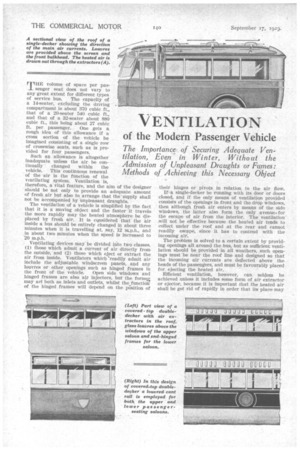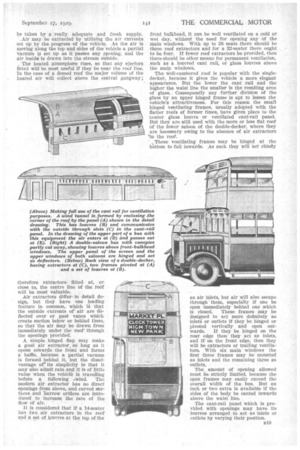V ENTI LATI 0 N T HE volume of space per pas
Page 52

Page 53

If you've noticed an error in this article please click here to report it so we can fix it.
senger seat does not vary to any great extent for different types of service bus. The capacity of a 14-seater, excluding the driving compartment is about 370 cubic ft., that of a 20-seater 540 cubic ft., and that of a 32-seater about 880 cubic ft., this being about 27 cubic ft. per passenger. One gets a rough idea of this allowance if a cross section of the vehicle be imagined consisting of a single row of crosswise seats, such as is provided for four passengers.
Such an allowance is altogether inadequate unless the air be continually changed within the vehicle. This continuous renewal of the air is the function of the ventilating system. Ventilation is, therefore, a vital feature, and the aim of the designer should be not only to provide an adequate amount of fresh air but also to arrange that the'supply shall not be accompanied by unpleasant draughts. The ventilation of a vehicle is simplified by the fact that it is a moving object and the faster it travels. the more rapidly may the heated atmosphere be displaced by fresh air. It is cqnsidered that the air inside a bus should be entirely changed in about three minutes when it is travelling at, say, 12 m.p.h., and in about two minutes when the speed is increased to 20 m.p.h.
• Ventilating devices may' be divided into two classes, (1) those which admit a current of air directly from the outside, and (2) those which eject or extract the air from inside. Ventilators which 'readily admit air include the adjustable windscreen panels, and any louvres or other openings such as hinged frames in the front of the vehicle. Open side windows and hinged frames are also atr injectors, but the forme.: may act both as inlets and outlets, whilst the functiOd of the hinged frames will depend on the position of
their hinges or pivots in relation to the air flow.
i a single-decker be running with its door or doors closed, and if the only means of ventilation provided consists of the openings in front and the drop windows, then although fresh air enters by means of the side windows, the latter also form the only avenues for the escape of air from the interior. The ventilation will not be effective because the heated air tends to collect under the roof and at the rear and cannot readily escape, since it has to contend with the incoming air.
The problem is solved to a certain extent by providing openings all around the bus, but as sufficient ventilation should be provided in all weathers, such openings must be near the roof line and designed so that the incoming air currents are deflected above the heads of the passengers, and must be favourably placed for ejecting the heated air.
Efficient ventilation, however, can seldom he achieved unless it includes some form of air extractor or ejector, because it is important that the heated air shall be got rid of rapidly in order that its place may be taken by a really adequate and fresh supply.
Air may be extracted by utilizing the air currents set up by the, progress of the vehicle. As the air is moving along the top and sides of the vehicle a partial vacuum is set up as it passes any ,opening, and the air inside is drawn into the stream outside.
The heated atmosphere rises, so that any ejectors fitted will be. most useful if they be near the roof line. In the ease of a domed roof the major Volume of the heated air will collect above the central gangway; therefore extractors, fitted at; or close to, the centre line of the roof will be most valuable.
Air extractors differ. in detail design, but the have one leading feature in common, which is that the outside currents of air are &fleeted over or' past vanes which create suction below or behind them, so that the air May be drawn from immediately under the roof' through the openings provided.
A simple hinged flap may make a good air extractor so long as it opens towards the front and forms a baffle, because a partial vacuum is formed behind it, but the disadvantage of4 its simplicity is that it may also admit rain and it is of little value when the vehicle is travelling before a following -wind. The modern air extractor has no direct openings from above, and curved surfaces and -narrow orifices are introduced to increase the rate of the flow, of air.
It is considered that if a 14-seater has two air extractors in the roof and a s.et of louvres at the top of the
front bulkhead, it can be well ventilated on a cold or wet day, without the need for opening any of the main windows. With up to 26 seats there should be three roof extractors and for a 32-seater there ought to be four. If fewer roof extractors be provided, then there should be other means for permanent ventilation, such as a louvred cant rail, or glass louvres above the main windows, The Well-cambered roof is popular with the singledecker, because it gives the vehicle a more elegant appearance. But the lower the cant rail and the higher the waist line the smaller is the resulting area of glass. Consequently any further division of the glass by an upper hinged frame is apt to lessen the vehicle's attractiveness. For this reason the small hinged ventilating frames, usually adopted with the flatter roofs of former times, have given place to the neater glass louvre or ventilated cant-rail panel. But they are still used with the more or less flat roof Of the lower saloon of the double-decker, where they are necessary owing to the absence of air extractors in the roof.
„These ventilating frames may be hinged at the bottom to fall inwards. As such they will act chiefly
as air inlets, but air will also escape through' them, especially if one be open immediately behind one which is closed. These frames may be designed to act more definitely as inlet g or outlets if they be hinged or pivoted vertically and open out
wards. If they be hinged on the rea'r edge then they act as inlets, and if on the front edge, then they will be extractors or trailing ventilators. With six main windows the first three frames may be mounted as inlets and the remaining three as outlets.
The amount of opening allowed must be strictly limited, because the open frames may easily exceed the overall width of the bus. But an inch or two extra is available if the sides of the body be canted inwards above the waist line.
The cant-rail panel which is provided with openings may have its louvres arranged to act as inlets or outlets by varying their position.




















































































































